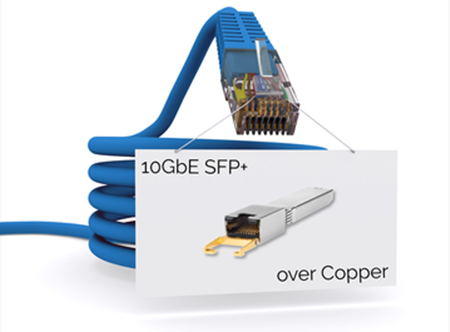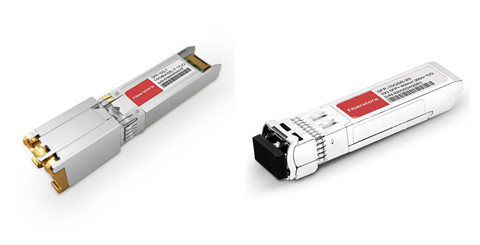Comparing 10GBASE-T SFP+ Transceiver Module With SFP+ SR/LR Optics & SFP+ DAC Twinax Cables
1000BASE-T SFP modules are available on the market as soon as the certification of Gigabit Ethernet network. However, 10GBASE-T SFP+ modules, owing to the technology limit, have not been supplied by vendors to support 10G copper networks. Instead, IT managers tend to use the cost-effective SFP+ direct attach cables (DAC) for short-reach 10G applications. Today, here comes a big news—vendors like HPE, Prolab, and FS.COM begin to offer 10GBASE-T SFP+ transceiver modules. Do you feel curious about them? This article will unveil the mysterious point of the 10G copper transceivers, and make a detailed comparison with SFP+ fiber modules and DAC twinax cables.
10GBASE-T SFP+ Transceiver Modules
10GBASE-T SFP+ transceiver modules are designed to meet the requirement of 10G longer-reach applications. Compared with SFP+ twinax copper cables (maximum distance is 10m), SFP+ 10GBASE-T transceiver modules operate over Cat6a/Cat7 with a link length of up to 30m. Seen from the below image, SFP+ 10GBASE-T transceiver terminates with a RJ45 connectors, which can be directly used in the RJ45 ports of 10G switches and NIC cards. What’s more, 10GBASE-T SFP+ module is announced to have lower power consumption (2.5W) than SFP+ Twinax DAC cables (4-8W).

Figure 1 shows how to plug a Cat6 cables in a 10GbE SFP+ module.
SFP+ 10GBASE-T Module Vs. SFP+ SR/LR Transceivers
In order to have a better understanding of the 10G copper modules, let’s compare the SFP+ 10GBASE-T modules with SFP+ SR/LR Transceivers and SFP+ DAC Twinax cables.
Both of the SFP+ copper and fiber modules are hot-pluggable with a managed soft-start and are interoperable with any SFP+ cage and connector system. However, they have total different performance when plugging into the 10G switches. SFP+ 10GBASE-T module uses the Cat6a cables for a link length of 30 m over RJ45 connectors. SFP+ SR operates over OM3 cables with a distance of 300m over LC connectors. While SFP+ LR optics utilizes the OS2 LC duplex cables for a distance of 10 km.

Figure 2 shows the SFP+ 10GBASE-T Module (left) and SFP+ SR Transceivers (right).
Note that 10G SFP+ transceivers are nowadays much cheaper than the newly released 10G copper module. For your reference, at FS.COM, Cisco SFP-10G-SR is offered at $16, Cisco stable SFP-10G-LR is &34. While Cisco SFP-10G-T is $380.
SFP+ 10GBASE-T Module Vs. SFP+ DAC Twinax Cabling
Whether to use SFP+ 10GBASE-T module and Cat6a cables or directly use the SFP+ DAC twinax cables for 10G short-reach application, it depends on your own network infrastructure.
- Linking Distance and Power Consumption
As noted before, the maximum linking distance of SFP+ 10GBASE-T module is 30m, while the SFP+ DAC twinax cable is 10m. Furthermore, SFP+ 10GBASE-T module have reduced the power consumption of 10G copper modules, which is a great news for the heavy-loaded 10G data center networks.
- Costs
For 10G intra-rack connection, SFP+ DAC twinax cables obviously cost lower than SFP+ 10GBASE-T copper modules and cat6a cables do. And you should also count the expenditure of 10G switches and NIC cards. 10G switches that can support 10G RJ45 ports are not available nowadays.
- Reliability
Compatible SFP+ Twinax cables have been used for years in 10G networks. So they are quite reliable. As for the SFP+ copper modules, RJ45 interface is rock solid. But many professionals said that technically it could work, but it is not supported for most of the switches. Thus, it is not popular nowadays.
Summary
Customers are very happy to see that there are new products kept coming out to keep in pace with the ever-increasing technology. SFP+ 10GBASE-T copper transceiver is introduced to have a better interoperability between existing fiber switches and 10G copper ports. Although there are still some unsolved problems of SFP+ 10GBASE-T transceiver module, we believe they will be solved in the near future.